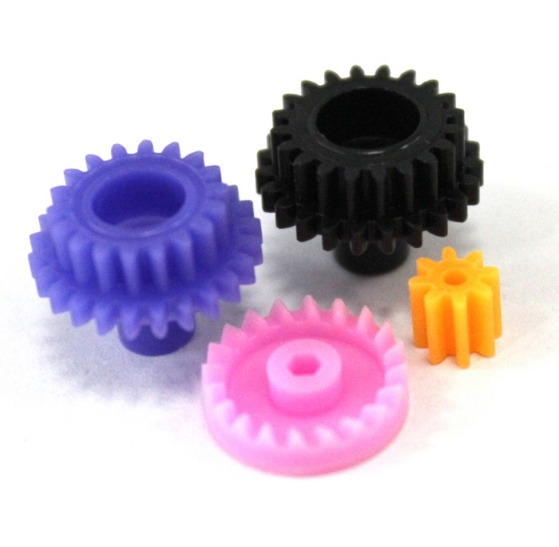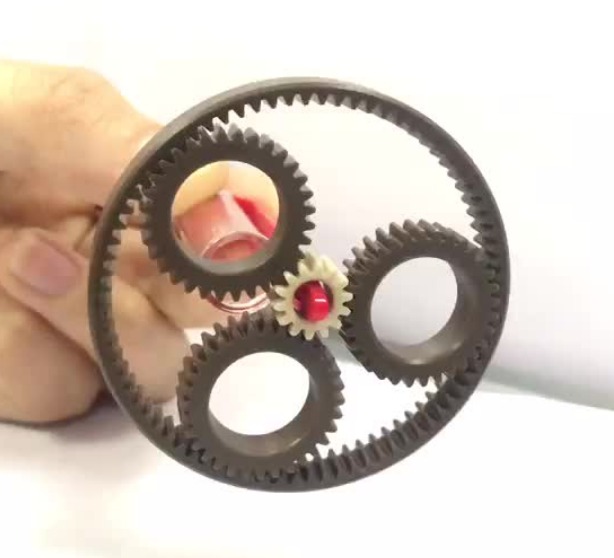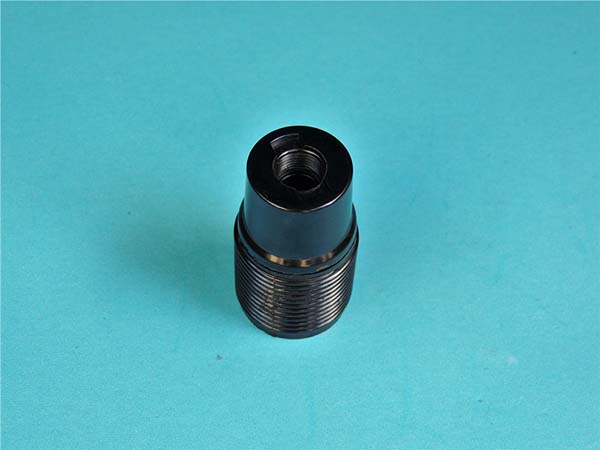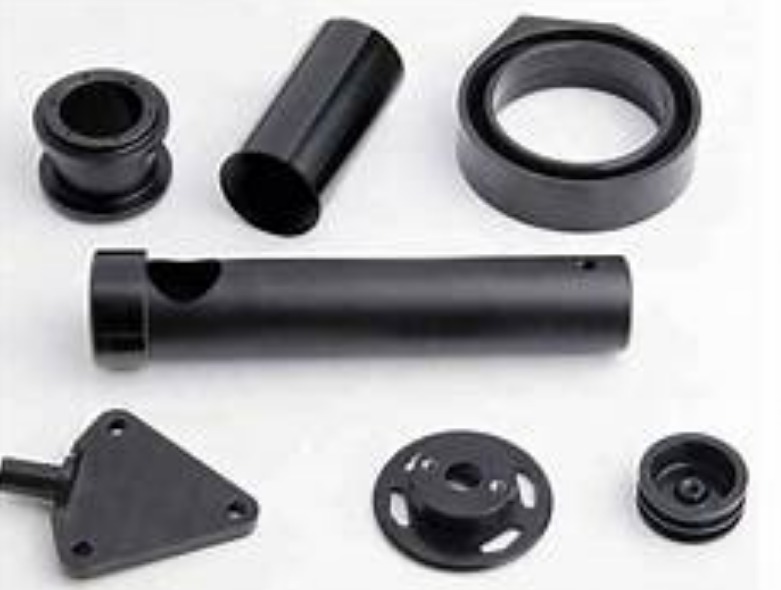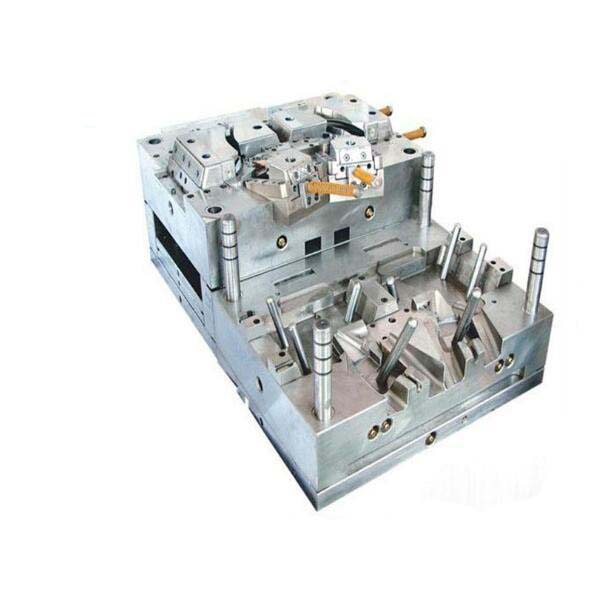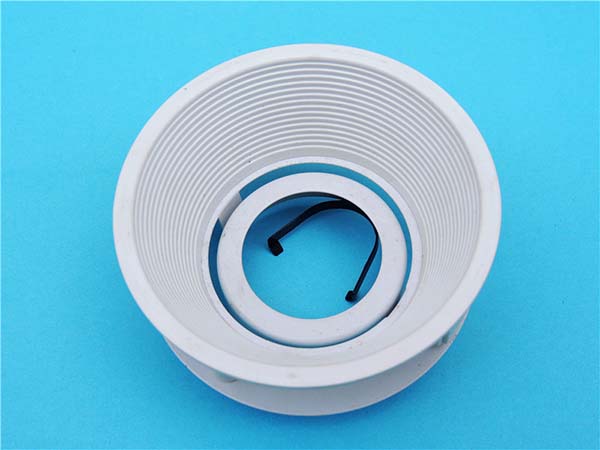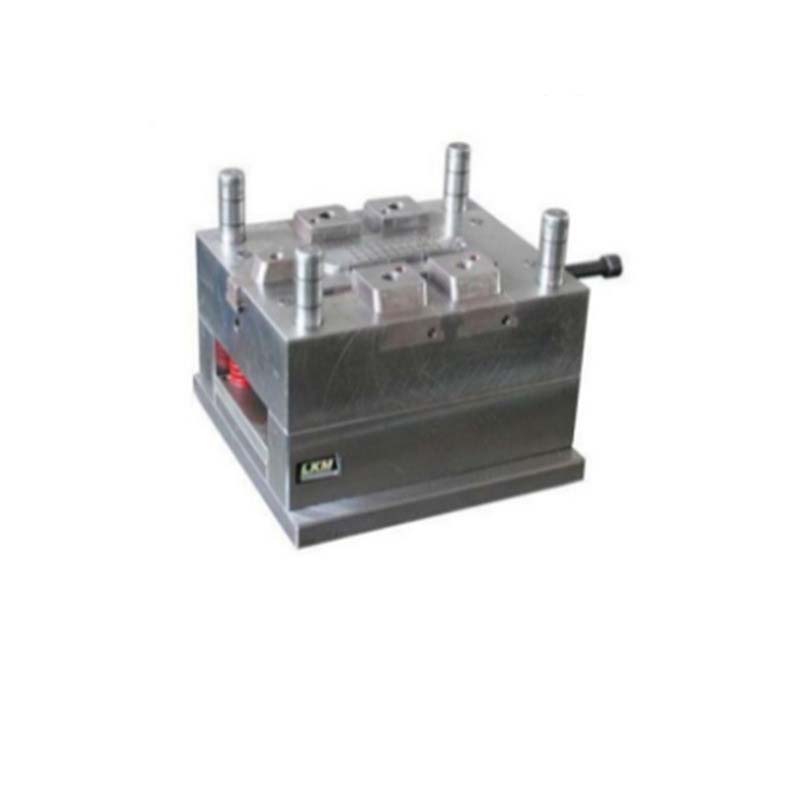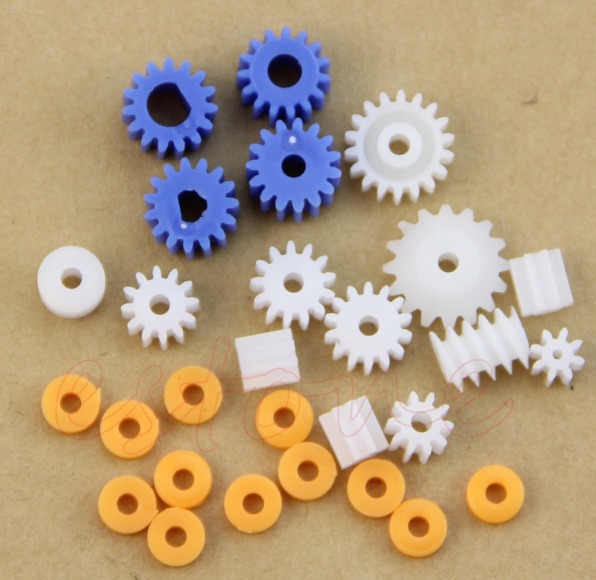1. Introduction
1.1 What is Plastic Drive Gear
A plastic drive gear is a fundamental component in gear systems, consisting of a toothed wheel made primarily of plastic materials. These gears play a crucial role in transmitting power and motion within various mechanical devices. They are designed with precisely shaped teeth that interlock with other gears to achieve the desired speed, torque, and direction changes.
Plastic drive gears come in different sizes, tooth profiles, and configurations, such as spur gears, helical gears, bevel gears, and worm gears. Each type is engineered to meet specific application requirements, whether it's in small consumer electronics, automotive components, or industrial machinery. For instance, in a small electric motor - driven device like a portable fan, a plastic spur drive gear might be used to transfer the rotational motion from the motor shaft to the fan blades, enabling the blades to rotate and generate air flow.
In contrast to their metal counterparts, plastic drive gears offer unique advantages that have led to their widespread adoption in modern engineering. They are generally lighter in weight, which is a significant advantage in applications where reducing overall mass is crucial, like in aerospace or battery - powered devices. This lighter weight not only helps in reducing the energy consumption required to operate the system but also contributes to easier handling and installation. Additionally, plastic drive gears are often more cost - effective to manufacture, making them an attractive option for high - volume production scenarios.
Moreover, plastics have inherent properties such as good corrosion resistance, which means plastic drive gears can perform well in environments where metal gears would be susceptible to rust and degradation. They also tend to operate more quietly, making them ideal for applications where noise reduction is a priority, such as in household appliances or office equipment. These characteristics make plastic drive gears an essential element in modern gear systems, unlocking new levels of efficiency and reliability across a wide range of industries.
3. Comparison of Plastic Drive Gears and Metal Drive Gears (in table form)
When considering the choice between plastic drive gears and metal drive gears, it's essential to evaluate their characteristics based on various factors. The following table provides a detailed comparison:
| Comparison project | Plastic drive gear | Metal drive gear |
| Weight | Typically, plastic drive gears are much lighter. For example, a common plastic spur gear used in a small - scale consumer device might weigh only about 10 grams, while a metal spur gear of the same size could weigh around 50 grams. The density of plastics is generally in the range of 0.9 - 2.3 g/cm³, compared to metals like steel with a density of approximately 7.85 g/cm³. This significant weight difference can be a crucial factor in applications where weight reduction is a priority, such as in battery - operated devices or aerospace components. | Heavier due to the high density of metals. As mentioned above, metals like steel have a much higher density than plastics, which results in a substantial increase in weight for metal gears of the same dimensions as their plastic counterparts. |
| Noise | Produce significantly less noise during operation. Research has shown that in a standard gear - meshing test, plastic gears can operate at noise levels about 10 - 15 decibels lower than metal gears. This is because plastics have better damping properties, which can absorb and reduce vibrations and impacts during gear meshing, making them ideal for applications like household appliances and office equipment where a quiet environment is desired. | Higher noise levels are often associated with metal gears. The hard and rigid nature of metals means that during the meshing process, impacts and vibrations are more likely to generate audible noise. In industrial machinery with large - scale metal gear systems, this noise can be quite substantial and may require additional noise - reduction measures. |
| Wear resistance | Offer good wear resistance, especially when made from high - performance engineering plastics. For instance, POM (Polyoxymethylene) plastic gears can withstand a significant number of operating cycles before showing signs of wear. In a laboratory - simulated wear test, POM plastic gears were able to endure over 100,000 cycles with only minimal tooth wear. However, the wear resistance of plastic gears can be affected by factors such as load, speed, and lubrication conditions. | Vary depending on the metal type. Steel gears, for example, can have excellent wear resistance when properly heat - treated. In automotive transmissions, hardened steel gears can operate for hundreds of thousands of miles with relatively low wear. But softer metals like some alloys may have lower wear resistance and may require more frequent replacement or maintenance. |
| Cost | Generally have a lower cost. The raw materials for plastic gears are often less expensive than metals. Additionally, the manufacturing process for plastic gears, such as injection molding, is more cost - effective for high - volume production. For a large - scale production run of 10,000 plastic gears, the cost per gear might be around $0.5, including material and manufacturing costs. This cost - effectiveness makes plastic gears an attractive option for mass - produced products. | Higher cost is mainly due to the more expensive raw materials and complex manufacturing processes. Metal gears often require processes like forging, machining, and heat - treatment, which increase the overall cost. For the same quantity (10,000) of metal gears, the cost per gear could be \(2 - \)5, depending on the metal type and manufacturing complexity. |
| Design flexibility | High design flexibility allows for the creation of complex shapes and geometries. For example, plastic gears can be easily molded with integrated features such as ribs, bosses, or even multiple gears in a single unit. This not only simplifies the assembly process but also reduces the number of components in a system. In some small - scale robotic applications, plastic gears are designed with unique tooth profiles and shapes to optimize power transmission and reduce space requirements. | Relatively limited in design flexibility compared to plastic gears. Metal manufacturing processes like forging and machining are more challenging and costly when it comes to creating complex geometries. Although modern manufacturing techniques like 3D printing are starting to change this, traditional metal - working methods still have limitations in terms of design complexity and cost - effectiveness for complex designs. |
| Strength | Meet requirements under specific conditions. For example, when the load and speed are within the designed range, high - strength engineering plastics like PEEK (Polyetheretherketone) can provide sufficient strength. PEEK plastic gears can withstand a torque of up to 5 N·m in certain applications. However, plastic gears may not be suitable for applications with extremely high loads or shock loads. | Generally have higher strength, making them suitable for high - load applications such as heavy - duty industrial machinery, large - scale power transmission systems, and automotive engines. In a large - scale industrial gearbox, metal gears can handle torques in the range of hundreds or even thousands of N·m. |
| Temperature resistance | Have certain limitations. Most common plastics start to experience a significant loss of mechanical properties at temperatures above 80 - 100°C. For example, ABS (Acrylonitrile Butadiene Styrene) plastic gears may soften and deform when exposed to temperatures around 90°C for an extended period. However, there are high - temperature - resistant plastics like PPS (Polyphenylene Sulfide) that can operate at higher temperatures, up to around 200°C in some cases. | Relatively better in terms of temperature resistance. Metals like steel can maintain their mechanical properties at much higher temperatures. For instance, steel gears can operate efficiently in environments with temperatures up to 400 - 500°C, making them suitable for applications in high - temperature industrial processes, such as in some furnace - related machinery or engines with high - heat - dissipation requirements. |
5. How to choose the right plastic drive gears
Selecting the right plastic drive gear is crucial for ensuring the optimal performance and reliability of a gear system. Here are several key factors to consider:
5.1 Consider the Working Environment
The working environment has a significant impact on the performance and lifespan of plastic drive gears. Temperature: Most plastics have specific temperature ranges within which they can maintain their mechanical properties. For example, common plastics like ABS are suitable for applications with operating temperatures generally below 80°C. In a high - temperature environment such as in some industrial ovens where the temperature can reach 150°C, high - temperature - resistant plastics like PPS should be used. Humidity: Humidity can affect plastic gears, especially those made from hygroscopic plastics like nylon. Nylon gears can absorb moisture, which may lead to dimensional changes and a decrease in mechanical strength. In a humid environment with a relative humidity of over 80%, special moisture - resistant treatments or the use of non - hygroscopic plastics may be necessary. Chemical substances: If the gear is exposed to chemicals, it must be resistant to those substances. For instance, in a chemical processing plant where there are acidic or alkaline substances present, plastic gears made from materials like PTFE (Polytetrafluoroethylene) are more suitable due to their excellent chemical resistance.
5.2 Load and Torque Requirements
Determining the load and torque requirements is essential for choosing the appropriate plastic drive gear. The torque \(T\) that a gear needs to transmit can be calculated using the formula \(T = F\times r\), where \(F\) is the force applied and \(r\) is the radius of the gear. For example, if a force of 50 N is applied at a radius of 0.1 m, the torque \(T = 50\times0.1=5\ N·m\). Based on the calculated torque, you can select a gear with an appropriate strength rating. High - torque applications require gears with a larger modulus and more robust construction. For instance, in a small electric vehicle's gear system that needs to transmit a relatively high torque of 10 N·m to drive the wheels, a plastic gear made from a high - strength engineering plastic like PEEK with a suitable modulus and tooth profile would be a better choice.
5.3 Precision Requirements
The precision requirements of the gear system will guide your gear selection. For applications with high - precision motion control, such as in a precision robotic arm where the positional accuracy of the joints is crucial, plastic gears with high - precision manufacturing tolerances are needed. These gears are often made using advanced injection - molding techniques that can achieve tight tolerances of ±0.05 mm or even less. In contrast, for less - critical applications like in a simple toy motor where the speed and motion control do not require high precision, standard - tolerance plastic gears can be used, which are more cost - effective. The manufacturing tolerance for these standard - tolerance gears may be around ±0.2 mm.
5.4 Cost Budget
Cost is always a significant factor in the selection process. While high - performance plastic drive gears made from advanced materials may offer excellent performance, they also come at a higher cost. For example, PEEK - based plastic gears are more expensive than those made from common plastics like ABS or POM. If your budget is limited and the application does not require extremely high performance, such as in a small - scale consumer product where the load and temperature conditions are not severe, ABS or POM plastic gears can provide a good balance between cost and performance. However, for high - end industrial applications where reliability and performance are non - negotiable, investing in more expensive, high - performance plastic gears may be necessary to ensure long - term operation and reduce maintenance costs.
6. Yigu Technology view
As a non - standard plastic and metal products custom supplier, Yigu Technology specializes in providing customized solutions for plastic drive gears. With our in - depth knowledge of various plastic materials, we can carefully select the most suitable material for each unique application. For instance, when dealing with high - torque applications, we might recommend PEEK, while for noise - sensitive scenarios, materials with good damping properties are considered.
Our expertise also extends to optimizing manufacturing processes. Whether it's injection molding, 3D printing, or other techniques, we ensure that the production process is fine - tuned to achieve high - precision results. This attention to detail allows us to meet the most demanding requirements of our clients, from complex gear geometries to tight tolerance specifications. By partnering with Yigu Technology, customers can expect high - quality plastic drive gears that enhance the efficiency and reliability of their products, giving them a competitive edge in the market.
7. FAQ
7.1 What load can plastic drive gears withstand?
The load - bearing capacity of plastic drive gears depends on multiple factors, including the material type, gear design, and manufacturing process. For example, gears made from high - strength engineering plastics like PEEK can generally withstand higher loads compared to common plastics such as ABS. In general, small - scale plastic spur gears made from POM might be able to handle a tangential force of around 50 - 100 N in normal operating conditions. However, this value can be significantly affected by the gear's modulus, tooth profile, and the distribution of the load across the teeth.
To increase the load - bearing capacity, techniques such as optimizing the gear design (e.g., increasing the tooth thickness, using a larger modulus), selecting a more suitable plastic material, and improving the manufacturing process to reduce internal defects can be employed. Additionally, proper lubrication can also help distribute the load more evenly and reduce wear, thereby enhancing the effective load - bearing capacity of the gear.
7.2 What is the lifespan of plastic drive gears?
The lifespan of plastic drive gears is influenced by several factors. Working conditions play a crucial role. In high - temperature or high - humidity environments, the material properties of plastic gears may degrade over time, reducing their lifespan. For example, if a plastic gear operates continuously at a temperature close to its heat - resistance limit, it may experience softening and accelerated wear.
Material quality is another key factor. High - quality plastics with better mechanical properties and durability will generally result in longer - lasting gears. For instance, gears made from high - performance engineering plastics are more likely to withstand repeated stress cycles without failure compared to those made from lower - grade plastics.
Lubrication also has a significant impact. Adequate lubrication can reduce friction between the gear teeth, minimizing wear and extending the gear's life. In a well - lubricated system, a plastic gear might be able to operate for thousands of hours in a low - load application. However, in a system with insufficient or improper lubrication, the gear may show signs of excessive wear and reduced performance after only a few hundred hours of operation.
To extend the lifespan, it is recommended to keep the working environment within the gear's specified temperature and humidity ranges, use high - quality plastic materials, and ensure proper lubrication. Regular inspection and maintenance can also help detect and address any potential issues early, further prolonging the gear's service life.
